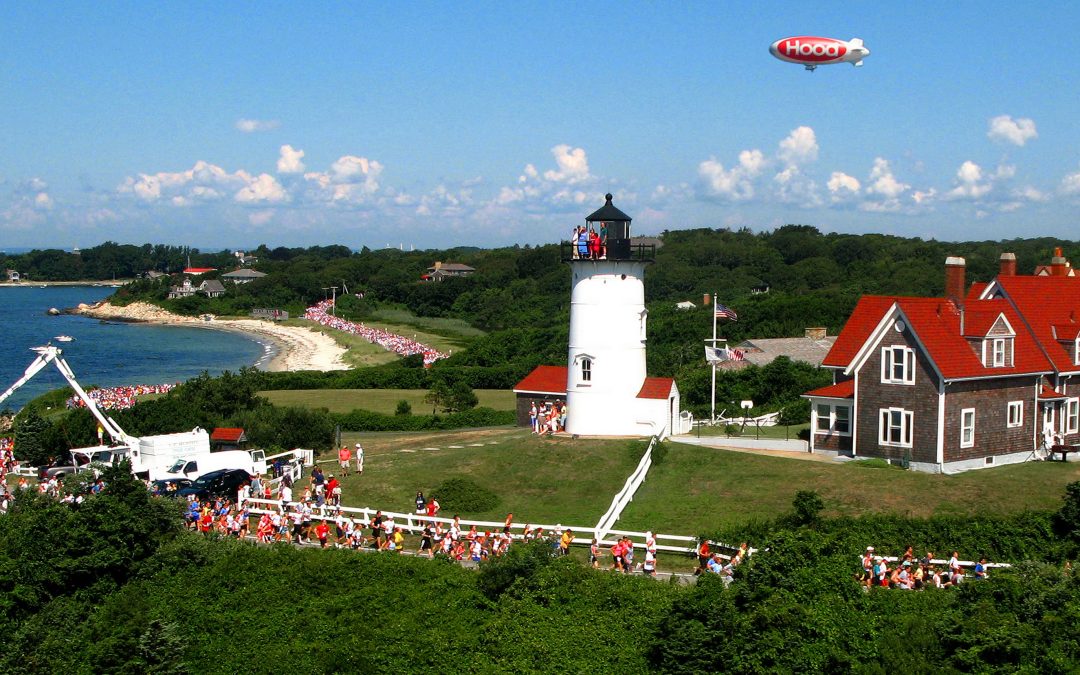By KAREN B. HUNTER
Some people will not fly in a single-engine helicopter, probably for obvious reasons.
Mashpee resident Paul Rifkin, however, does so every chance he gets, which amounts to about once a week when his pilot friend is in town during the summer months.
Each ride is a golden opportunity for Mr. Rifkin to take hundreds of aerial photographs, from Plymouth to the outer Elizabeth Islands off of Woods Hole, to Nantucket and Martha’s Vineyard, and around Cape Cod from Falmouth to Provincetown.
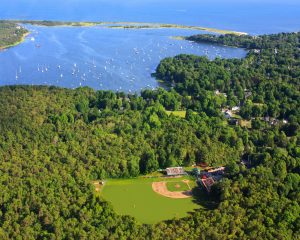
PAUL RIFKIN
Lowell Park and Cotuit Harbor
Mr. Rifkin has been taking photographs all of his life, starting with the Polaroid camera he had as a young boy.
Here on the Cape, his photographs often appear in the Enterprise newspapers as well as the Cape Cod Times and the Boston Globe. He has also reached a wider audience with photographs in Yankee Magazine and The New Yorker.
Fifteen years ago, while still owner of the Moonakis Café, Mr. Rifkin expanded his passion into aerial photography when a customer who owned a helicopter asked if he wanted to go for a ride.
“I have flown maybe 100 times in 15 years, and my pilot never charges me,” Mr. Rifkin said. “We like each other’s company. We don’t talk politics, and the whole experience is always positive.”
Whether on land or in the air, Mr. Rifkin likes to wed his photography with his community activism.
During the years he worked with Cape Downwinders to get the Pilgrim Nuclear Power Station closed, his pilot friend took him there for photos, in part so Mr. Rifkin could test a Pilgrim manager’s assertion that air space over the plant was secure.
“The view was dramatic, and we never got a call from anyone to stop us flying over,” he said.
Examining Mr. Rifkin’s photos, engineers in the Cape Downwinders group noticed a structure built near the plant that had been done without permission by the Town of Plymouth Zoning Department.
This feat earned Mr. Rifkin a paragraph in a New Yorker Magazine article about the Pilgrim Nuclear Plant. The magazine used his photos for the story.
In addition to his activism, Mr. Rifkin uses his aerial photos in the service of local towns.
When the Town of Falmouth was considering dredging at Menauhant Beach, Mr. Rifkin took aerial photos documenting different layers and depths of sand, and gave them to the town.
An aerial photograph he took eight years ago of Lowell Park in Cotuit has been used by the Cape Cod Baseball League to publicize its events, and enabled him to get to know the commissioner of the league.
“Many people say it’s the best shot of Cotuit there is. It has never been duplicated,” Mr. Rifkin said.
“Part of my desire is to capture the beauty of Cape Cod,” Mr. Rifkin said. “It is amazingly rewarding in that regard.”
“My photography also brings me to people. That’s what I love about it,” he said.
When Mr. Rifkin’s aerial photos are printed in the local newspapers, people call him to ask about buying copies. A woman called to ask about buying a copy of a red sailboat sailing around Sandy Neck Lighthouse, who turned out to be a former neighbor from Long Island decades ago. She invited him to dinner.
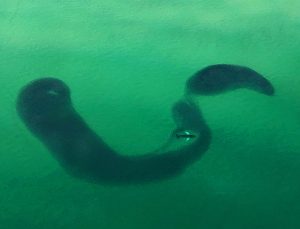
PAUL RIFKIN
A humpback whale feeds on a school of menhaden off Chatham.
When a photo of a sailboat going around Nobska Light was published, a man called Mr. Rifkin to say he was the sailor and invited him to go out on the boat. He has been sailing with the man every summer since then.
The shot Mr. Rifkin calls “the best photo I ever took in my life” is of a humpback whale eating its way through a pod of menhaden off the coast of Chatham.
A second passenger was aboard the day of that flight and Mr. Rifkin sat in the back seat of the helicopter. Through thick earphones they are required to wear, he heard the pilot and the other passenger talking about something below, but he couldn’t see what it was out the small side window.
He put his camera to the window and hit the shutter.
Enlarging the photo on his computer, Mr. Rifkin could see that from the air, the school of fish was so thick and large it looked like a single organism, which made the whale look like a guppy.
“The photo of the whale eating hundreds, perhaps thousands, of fish was a force of nature, an aspect of the dog-eat-dog world, Mr. Rifkin said.”
“At the same time it was a scene that was complete, peaceful and serene to photograph. It was ferocious and peaceful at the same time,” he said.
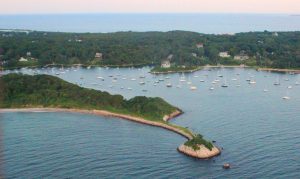
PAUL RIFKIN
The Knob and Quissett Harbor in Falmouth
“I don’t want my photos to be just of something, I want them to say something,” he said. “You have to know the difference between photos that are meaningful and those that are not. I gasped when I saw the intensity of that whale photo.”
“I didn’t take that photo,” he said. “God took that photo.”
A Falmouth couple, both neuroscientists, were interested in the whale photo. The wife called Mr. Rifkin to ask about buying a copy for her husband and they met so he could sign the photograph.
“In general, neuroscientists don’t call me. This is an example of how my photography broadens my horizons,” he said.
Mr. Rifkin said that aerial photography teaches him things, as it did when he took the whale photo.
“I’m not a fisherman. I didn’t know menhaden from Manhattan,” he said, revealing his New York roots. “I do research, I educate myself, my mind grows. It’s an expanding system of growth for me that I cherish.”
Photographing by air has also helped Mr. Rifkin put his life into perspective. Because it can be tricky to get a good photograph through the helicopter’s windows when the sun causes glare, they occasionally remove the doors before flying.
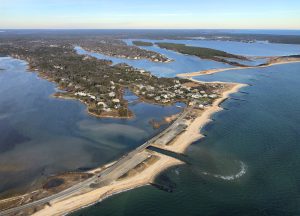
PAUL RIFKIN
The inlet to Bournes Pond at Menauhant Beach in Falmouth.
“I am belted in, but the first time I leaned out to take a photo and there was nothing beneath me, I felt an inner fear,” Mr. Rifkin said. “There was nothing between me and what I wanted to capture, although the sharpness woke up my brain and balanced the fear.”
Then he asked himself what was the worst that could happen if he fell out of the helicopter.
“I realized that if I fall out, I will have my camera and I’ll be taking pictures on the way down. What more could I ask?” he said. “After that, the fear was completely erased. That thought has stayed with me and it is a point of real comfort.”
“I have seen things I couldn’t have imagine existed,” he said, such as the Scottish longhorn cattle on Nashawena Island. “To see sights like that thoroughly amaze me.”
Mr. Rifkin’s favorite place to shoot by air is Chatham, he said. “The coast is alive with whales and great white sharks and seals,” he said. “It has a really dramatic coastline as you head to the Outer Cape.”
Also, scenes of erosion, houses lined up precipitously waiting for the next storm, a scene representative of where the Cape is going as the climate changes, he said.
When Mr. Rifkin and his pilot friend stop for gas at the Chatham airport they have breakfast, which Mr. Rifkin buys, at the Hanger B Restaurant, where the food, he said, is almost as good as the food at the Moonakis Café.
“Since I retired from the restaurant, I feel that when I go out with a camera, God presents me with images of pure delight and I simply press the shutter. It is a transcendent experience which happens to me almost on a daily basis.
“The feeling I have is that I am really happy and comfortable with my life and with what I have accomplished,” the 79-year-old Mr. Rifkin said. “This has made me really relaxed about the end of me. It’s a nice feeling to walk around with.”
That said, Mr. Rifkin emphasized that he is not ready to leave yet. “I have more photos to take and more causes to serve,” he said.

